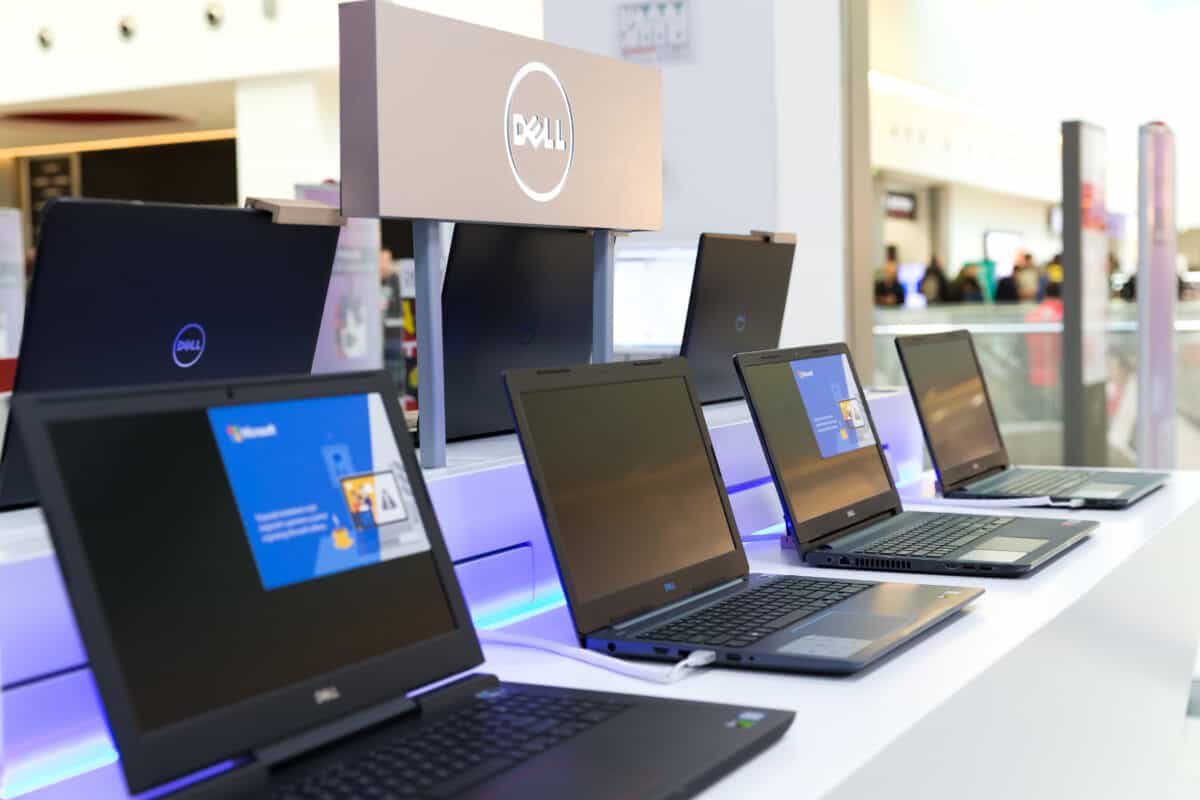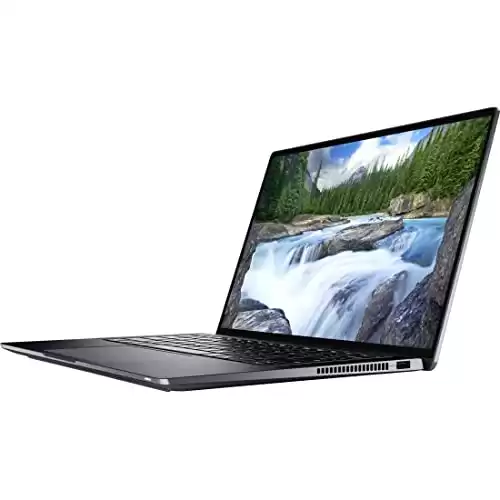Loved by enterprise users, the Dell Latitude has gained a reputation for being a sturdy and reliable laptop. While some laptops focus on aesthetic designs and quirky features, the Latitude is all business, from its rugged chassis to its highly repairable construction.
In this article, we go deep into Latitude, one of the longest-running laptop lines, with a history spanning almost thirty years. We will explore this laptop in detail, from the earliest models to the current lineup, and see why it has been successful.
Dell Latitude: Best Deal Today
The Dell Latitude is one of the best laptops you can buy if you are trying to get a high-performance laptop at a low price. However, with so many different models to choose from, it can be challenging to find the best one. That’s why we’ve scoured the internet to find the best deals on the latest Latitudes and compiled them here:
- Intel Core i5 1.10 GHz processor provides great performance, immersive multimedia and rapid loading of programs
- With 16 GB of memory, runs as many programs as you want without losing the execution
- The 14" 2560 x 1600 screen provides a great movie watching experience
- With Windows 10 Pro edition, enjoy your favorite content all at once on a larger view edge browser. Share your thoughts with the world by writing directly on web pages.
- 256 GB total SSD capacity keeps your running programs active while your computer resumes from suspension in seconds
Dell Latitude: History
Despite Michael Dell starting the company in 1984, it wasn’t until 1989 that the first laptops were released. The Dell Latitude became Dell’s business-focused system after the company realized massive success in the corporate and business market. The first model ever made was the Latitude XP, initially launched in 1994. Since then, the Latitude line has grown to include models with different screen sizes, features, and use cases.
Latitude has kept business users in mind, focusing on battery life and neutral design. Additionally, Dell often stuck with tried-and-true industry-standard features instead of testing the waters with new technology. While the Dell Latitude was never on the cutting edge, it did provide a reliable user experience.
Dell Latitude: Different Versions
Let’s explore each generation in more detail.
Dell Latitude XP
| Release Date | 1994 to 1998 |
| Processor | Intel 486 DX4, Intel Pentium |
| Operating System | Windows 3.1, Windows 95 |
| Memory | 8MB to 36MB |
| Display | 800 x 600 STN or TFT |
The first Dell Latitude was released in 1994 and dubbed the Latitude XP. It was immediately praised for its long battery life and was one of the first laptops to feature a removable lithium-ion battery. The dual-scan STN color display was also impressive to see on a laptop. Although the specs are laughable by today’s standards, this laptop was considered a reasonably powerful machine.
The next addition to the Latitude family came in 1996 with the release of the Dell Latitude XPi. The Latitude XPi came with the more powerful Pentium 133MHz processor and a TFT display. Additionally, this model was the last to feature a trackball instead of the typical trackpad we are used to today.
By 1997, the newest addition to the XP family of Latitudes was released: the Latitude XPi CD. As the name suggests, this model featured a CD-ROM drive, a sought-after feature on laptops at the time. Production ceased on the Dell Latitude XP series by 1998 and was rapidly replaced by an even more potent lineup of laptops.
Dell Latitude CP and CS Generation
| Release Date | 1997 to 1999 |
| Processor | Intel Pentium MMX, Pentium II, Intel PIII Mobile |
| Operating System | Windows 95, Windows 98 |
| Memory | 128MB to 512MB |
| Display | 800 x 600 TFT or 1024 x 768 CCFL |
The next generation of Dell Latitudes featured the new Intel Pentium MMX processor, running at a clock speed of 166MHz to 233MHz. This new generation was an improvement in several areas, from the increased RAM capacity to the upgraded graphics and display.
Over the next several years, Dell released minor upgrades to the Latitude lineup. By 1999, the latest models shipped with Intel PIII Mobile processors and support for up to 512MB of RAM. Additionally, screen resolutions were bumped up to 1024 by 768 using CCFL displays.
Dell Latitude L Generation
| Release Date | 1999 to 2006 |
| Processor | Intel PIII Mobile, Intel Pentium M, and AMD Turion 64 X2 |
| Operating System | Windows 98, 2000, ME, and XP |
| Memory | 32MB to 256MB |
| Display | Up to 1280 x 800 CCFL |
By 1999 Dell was already on to the next generation of laptops. Between 1999 and 2006, Dell extensively upgraded the entire Latitude series, launching new models yearly. The Dell Latitude LS, the first model in this generation, shipped with Windows 98 and an Intel PIII Mobile processor.
This generation would see the most substantial upgrades over the course of its seven-year existence.
The Dell Latitude 131L, released in 2006, was the last model in this generation. With upgrades like an AMD Turion X2 processor, DDR2 RAM, and a 1280 by 800 display, the Latitude 131L was the most potent Latitude yet. Thanks to the new DDR2 memory, users could add as much as 2GB of RAM. Additionally, support for Windows XP made it extremely popular.
Dell Latitude C Generation
| Release Date | 1999 to 2002 |
| Processor | Intel PIII Mobile, Intel P-4 M, and Mobile Intel Celeron |
| Operating System | Windows 98, 2000, ME |
| Memory | 512MB to 1GB |
| Display | Up to 1600 x 1200 CCFL |
The Dell Latitude C-series ran from 1999 to 2002. During this time, Dell expanded the most crucial capabilities by using newer processors and faster RAM standards. The first model, the CPx J650GT, shipped with an Intel PIII Mobile processor and up to 512MB RAM. Most users praised the innovative trackpad and the long battery life.
The C-series was shortlived, with the Dell Latitude C840 being the last of its kind in 2002. Around this time, Dell dabbled in variations of the Latitude, such as the V-series and the X-series. All of these models have been mostly forgotten, especially in the wake of the next generation that Dell would produce.
Dell Latitude D Generation
| Release Date | 2003 – 2007 |
| Processor | Intel Celeron M, Pentium M, Core 2 Duo, and AMD Turion 64 X2 |
| Operating System | Windows XP, Windows Vista |
| Memory | 1GB to 8GB |
| Display | 1280 x 800 CCFL |
Initially launched in 2003 with the Dell Latitude D800, this new generation brought massive innovation and upgrades to the Latitude lineup.
By 2006, Dell began using the new Intel Core 2 Duo processors in most high-end Latitudes. The Intel Core 2 Duo was one of the earliest dual-core CPUs and allowed users to experience a level of power you could only find in a desktop computer at the time. The new processor also supported the latest DDR2 RAM, allowing users to install up to 8GB of memory. Although 8GB of RAM is average today, it was unheard of at the time.
The D-series was offered in multiple screen sizes to cater to different buyers. The smallest was the 12.1” Dell Latitude D400, weighing in at just 1.7kg. Aimed at traveling professionals, this model was a hit due to its compact size and good processing power. Dell also produced a 14.1” model and a 15.4” model to cater to users seeking a larger display. The larger models were also special because they came with the most powerful processors.
The D-series models were produced in 2007 and were succeeded by the E-series starting later that year.
Dell Latitude E Generation
| Release Date | 2007 to 2017 |
| Processor | Intel Core 2, Intel Core i3, i5, and i7 |
| Operating System | Windows Vista, 7, 8.1, 10 |
| Memory | 2GB to 32GB |
| Display | 800 x 600 Dual Scan STN Color |
The introduction of the E-series Dell Latitude in 2007 spelled a new chapter in the history of this famed laptop. The machine would undergo several notable changes in this period, starting with the RAM. Despite the earliest models coming with DDR2, Dell had already upgraded the latest Latitudes with DDR4 memory by 2016.
Over the course of the E-series, Dell also offered a variety of processors for Latitude. While the earliest models were available with Intel Core 2 Duo processors, these were quickly phased out in favor of Intel’s new i-series processors. Additionally, this generation was the first to offer the latest features like LED full 1080p HD displays, Wireless AC, and Bluetooth. Some of the highest-tier models even offered things like discrete graphics processors.
Dell Latitude Current Generation
| Release Date | 2017 to the present |
| Processor | Intel Core i3, i5, and i7 |
| Operating System | Windows 10, Windows 11 |
| Memory | 8GB to 32GB |
| Display | Up to 3840 x 2160 WVA |
The current generation of Dell Latitude has been produced since 2017 and has brought numerous innovations to the Latitude lineup. Most of the newest Latitudes use low-profile DDR4 memory, solid-state drives, and 11th-generation Intel CPUs.
Additionally, the displays have improved drastically since previous generations. Dell Latitudes now come standard with IPS or WVA display panels, packing up to 3840 by 2160 resolution. The latest Bluetooth and WiFi standards are also common features on these machines.
Dell Latitude: Review

©N.Z.Photography/Shutterstock.com
Despite decades of innovation and improvement, the Dell Latitude has remained true to its original mission: to be a business computer. The Latitude still retains its sturdy, repairable design. Features like easy-access bottom panels make it easy to change or upgrade components. Swapping components like RAM, hard drives, and even processors are possible on most Latitudes using nothing more than a screwdriver.
Dell Latitudes are geared towards business and corporate environments. The features available in Latitudes, including smart card readers, Kensington locks, and docking stations, further add to their appeal for business. When you consider the corporate discounts Dell is known to offer, it becomes even more apparent why businesses love Latitude.
This environment creates a unique secondary market for these laptops. Since corporate clients typically upgrade their computers every three to five years, a massive surplus of Dell Latitudes becomes available every few years. When corporate clients upgrade to newer systems, the older systems get refurbished and reused. It’s not uncommon to see refurbished Latitudes selling online for a fraction of retail value.
Dell Latitude: Pros and Cons
Pros:
- Affordable
- Sturdy build quality
- Great battery life
- Easy to repair
Cons:
- Poor graphics performance
- Not the brightest display
- Basic aesthetics
Dell Latitude: Is it a buy?
A Dell Latitude is often a good choice for someone looking for a no-frills, basic laptop. That’s not to say the laptop isn’t a powerful system. The latest models come with the latest Intel Core series processors, discrete graphics, and massive amounts of memory and storage.
Buy it if…
You want a sturdy, reliable laptop with a basic design. The Dell Latitude has never tried to be the thinnest or the most attractive design, but it offers solid built-quality and a plethora of modern features. If you are looking for a new Latitude, it’s often easy to find one with the latest features like touchscreen display or convertible tablet form factor.
Additionally, if you’re on a budget, a refurbished Latitude is often an excellent solution for a student, office worker, or someone who just needs a reliable laptop.
Don’t buy it if…
You want a machine with gaming performance or need to have the most cutting-edge features. While the best Dell Latitudes have reasonable graphics, they are not designed for gaming. If you are hoping to do anything graphics intensive, whether gaming, streaming, or video editing, it is best to consider a gaming laptop.
Check out the Dell a mid-range range laptop on Amazon.
NEXT UP…
- M1 Pro Vs. M1 Max: Improved Performance and Power Efficiency
- Alienware x14: Full Review of a Compact Gaming Laptop
- Best 2-IN-1 Laptops For Business: Reviewed
The image featured at the top of this post is ©Ken Wolter/Shutterstock.com.








